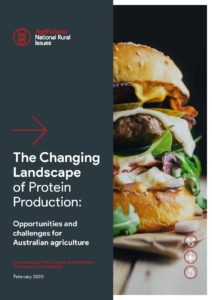The AgriFutures Australia and Australian Farm Institute report The Changing Landscape of Protein Production: Opportunities and challenges for Australian agriculture outlines the size of the alternative proteins trend and unpacks the likely implications for the agricultural sector. The report found additional opportunities for the protein market in 2030 are estimated at $19.9 billion, of which $3.1 billion will come from alternative protein categories.
With these figures in mind, AgriFutures Australia Senior Manager Rural Futures, Jennifer Medway explained the emergence of alternative proteins shouldn’t be seen as a threat, but rather a means of diversification for producers, processors and consumers.
“The report was compiled to help us understand the future of the protein market following industry concerns that traditional proteins could be at risk of losing market share with an increase in vegetarian, vegan, flexitarian and meat reducer diets,” said Ms Medway.
“Instead, we found there are huge opportunities globally in both the traditional and alternative protein markets. There will be a rise in consumption of alternative proteins, but people will also continue to eat meat – the two industries can co-exist and can complement each other.”
The current state of play in the protein field
The Australian plant-based protein market has enjoyed substantial global investment over the past 12 months. Australian start-up v2food, a joint venture between CSIRO, Competitive Foods and Main Sequence Ventures raised $77 million in funding in October 2020, bringing their total funding to $113 million[1], while in May 2021, global grain trader and agrifood company Bunge invested A$45.7 million in Australian Plant Proteins (APP), a premium plant-based powder processing, packaging and distribution business, with facilities in regional Victoria.[2]
In addition to increased investment, Executive Director of Australian Farm Institute, Richard Heath said there has been strategy development and advocacy from all parts of the protein value chain since the report’s release.
“In March this year, leading Australian plant-based companies including Sanitarium, Proform Foods, v2food, Rogue Foods and Nestlé Australia, along with Impossible Foods from the United States, launched the Alternative Proteins Council (APC) to lobby for positive outcomes in the Australian sector[3]. We’ve also seen traditional protein industry groups establishing taskforces and other industry efforts, such as consumer sensory testing[4], to promote and protect animal protein production.”
Meanwhile in the United States, the House of Representatives in Texas approved House Bill 316 to stop alternative proteins from being labelled as ‘meat’, ‘beef’, ‘chicken’ or ‘pork’. A sign of what’s on the horizon, international policy trends around labelling and ‘what’s in a name’ are likely to be closely followed by Australian food producers as the alternative protein market grows.
Opportunity knocks for emerging industries
The face of alterative protein is changing, with new products on the market and innovative emerging industries in Australia stepping up to meet demand.
In 2020, v2food released their first product, the Rebel Whopper, across Hungry Jack’s stores throughout Australia, and have since expanded to include plant-based mince, sausages and burger patties that have been rolled out in supermarkets and meal kit services across the country.
Speaking at evokeAG last year, Nick Hazell, Founder and CEO of v2food said that consumers don’t change their eating habits very quickly, and the trick with plant-based meat is to make it perform in exactly the same way as traditional animal protein.
“We need to work with what we like, design a food system and food that fits in with who we are and what we like, rather than trying to force people to change too much.”
Ms Medway said jackfruit and edible insects are two stand out examples of Australian emerging rural industries that have been a staple in many cuisines for centuries but are now pivoting to meet consumer demand and eating habits in the western world.
“Protein powders, protein bars, dukkah, seasonings and roasted insects are just some of the ways that insects can be consumed, while jackfruit, which grows in northern Australia, boasts similar attributes to ‘pulled pork’,” she said.
“On a per hectare basis, jackfruit produces high yields of edible food products. One project that AgriFutures Emerging Industries Program is currently supporting is developing processing systems to create ready-to-eat jackfruit products[5].”











